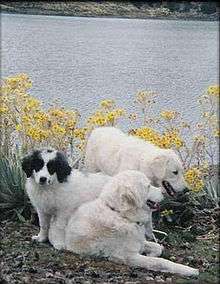Mucuchies
 | |
| Other names |
Venezuelan Sheepdog Dog of Páramos (Perro de los Páramos) |
|---|---|
| Origin | Venezuela |
| Domestic dog (Canis lupus familiaris) | |
Mucuchí (Venezuelan Sheepdog) is a dog breed from Venezuela (specifically from Sierra Nevada de Mérida). The dogs have a short coat with feathering along their limbs. The coat color is either white or white with splashes of colors such as honey or tan, or shades of black and gray.
Appearance
A mucuchí is a relatively large (30–50 kg)[1] dog, sturdily built, of pleasant appearance and a certain grandeur, brown eyes of kindly expression. It is an animal of great energy and despite having developed the instinct of monitoring, which always keeps it on alert, it is deliberate and safe.
- Color: pure white, white with patches in various shades of honey color and white with black spots. Red or reddish spots, gray spots, tan with white spots or black with white spots are considered defects.
- Size: are between 55.9 and 71.1 cm (22-28 inches).
- Weight: for the adult specimens the weight should be 33-50 kg for the male and 30–37 kg for the female.
- Head: Long, of wedge-shape (triangular), 20 to 23 cm from the external occipital protuberance to the tip of the nose; rounded forehead, slightly wrinkled brow furrows.
- Ears: medium-sized, triangular in shape but rounded at the tips, placed slightly above the parallel line of the eyes, tight to the head and that only rises in reactions of attention and alert.
- Eyes: oblique, brown, expressive with well pigmented eyelids.
- Lips: thin and glued (not pendulous), lined black, like the nose, which is always black.
- Gill and Ruff: well developed but not exaggerated.
- Neck: short, strong and muscular.
- Body: shoulders well placed obliquely, wide and straight back, prominent haunches with the rump declined slightly; ribs more flat than arched; deep chest. Spine arched up or down is considered a defect.
- Tail: longer than the hocks, with abundant fur, palm or fan shaped. It remains low at rest; raised (never reaching full circle) when alert.
- Coat: rich and thick (woolly), strong hairs, can be straight or slightly wavy.
Origin
Mucuchies are believed to descend from dogs introduced by Spanish conquerors at the end of the 16th century as watchdogs and herders. It is possibly a descendant of the Spanish Mastiff, the Pyrenean Mastiff, Algerian Mastiff, the Atlas Shepherd Dog or Aidi, and the Great Pyrenees. Over the years these dog breeds mixed, ultimately creating a powerful and versatile working dog. Others suggest that Mucuchies were deliberately bred by veterinarian Dr. Wilender Ferrari.
Its importance in Venezuelan history came after Simón Bolívar reached the town of Mucuchíes in Venezuelan Andes of Mérida state during his struggle for Venezuelan independence and subsequently adopted a dog of this breed.
During 1926-27 Mucuchies were found throughout Venezuela. After the wide distribution of the breed, its purity and quality was in serious decline in the early part of the 20th century. In 1961 a club was created to preserve the breed, and by 1964 it was declared the Venezuelan "National Dog". The club then appears to have disbanded, which would mean an uncertain future for the breed.
In 2008, in order to preserve the national breed, MINTUR (el Ministerio del Poder Popular para el Turismo),[2] led at the time by Titina Azuaje, approved the creation of the Fundación Nevado (Funev), with six of these dogs transferred to the Waraira Repano Cable Car System in El Ávila National Park, where similar environmental conditions to the Andes exist. The success of this effort led President Hugo Chávez to encourage and amplify this program.
Qualities

Mucuchíes were originally shepherd and a guard dogs. The first quality was lost due to a shortage of cattle in the Andean moors, but it retained its guardian aspects. It has a strong character, is very active, gentle and loving towards its family, but may react violently against strangers unless trained and socialized properly. It should always have double spur on the hind legs and a single in the front.
Temperament
The Mucuchíes are very emotional, intelligent and active dogs. Socialization and training are necessary. It can be aggressive with strangers.
Care
It should be given daily walks, preferably taken at a trot. It requires a wide area where to run and play. Not much grooming is required.
Famous Mucuchies

- Nevado was Simón Bolívar's dog, and was with him during voyages and battles until his death.
When arriving at a local mansion, the Hacienda Moconoque, Simón Bolívar was received by "Nevado", which despite being a puppy was not intimidated before the weapons and threats of the army men. De Mendoza explained that Bolívar was surprised at the dog's courage, who did allow the group to enter the hacienda until its master came out. Nevado accompanied him throughout the campaign, fought in several countries and often saved his life. One popular story tells that Nevado was abducted by the royalist army, which did not kill him because they thought the dog would lead them to Bolivar. However, the dog escaped and reunited with Bolivar. Nevado was killed by a spear during the Battle of Carabobo on 24 June 1821, which sealed Venezuela's independence from the Spanish Crown. Nevado also appears in various historical paintings and a known statue which features him alongside the Indian Tinjacá in Mucuchíes.
- Simón is Cristina Fernandez's dog, a gift to her from a brother of Hugo Chavez.
- Progreso and Esperanza, Henrique Capriles's dogs, donated during his 2012 presidential campaign in Mérida.[3]
See also
- Akbash Dog
- Great Pyrenees
- Kuvasz
- Maremma Sheepdog
- Pyrenean Mastiff
- Polish Tatra Sheepdog
- Slovak Cuvac
References
External links
| Wikimedia Commons has media related to Mucuchies. |